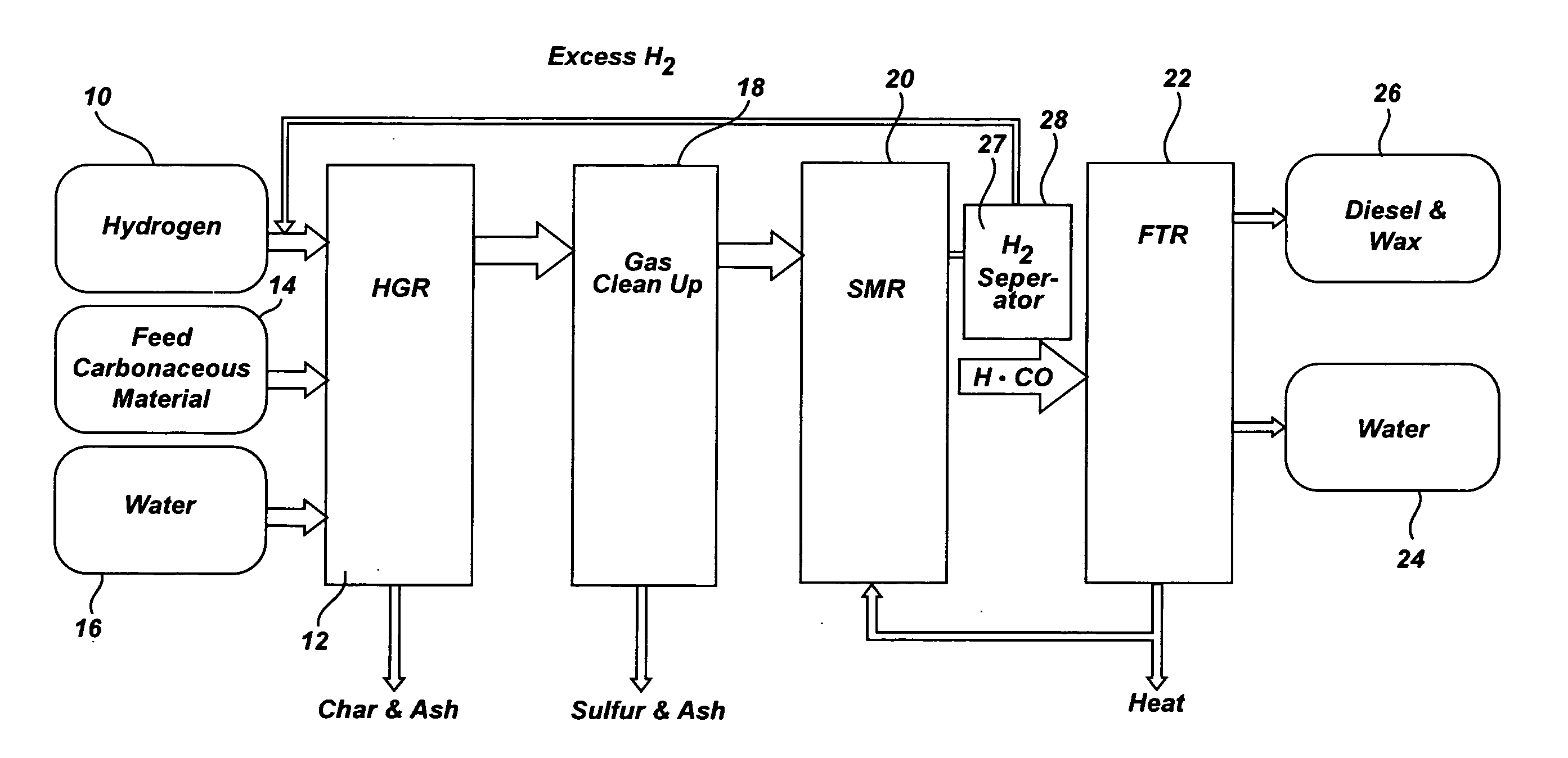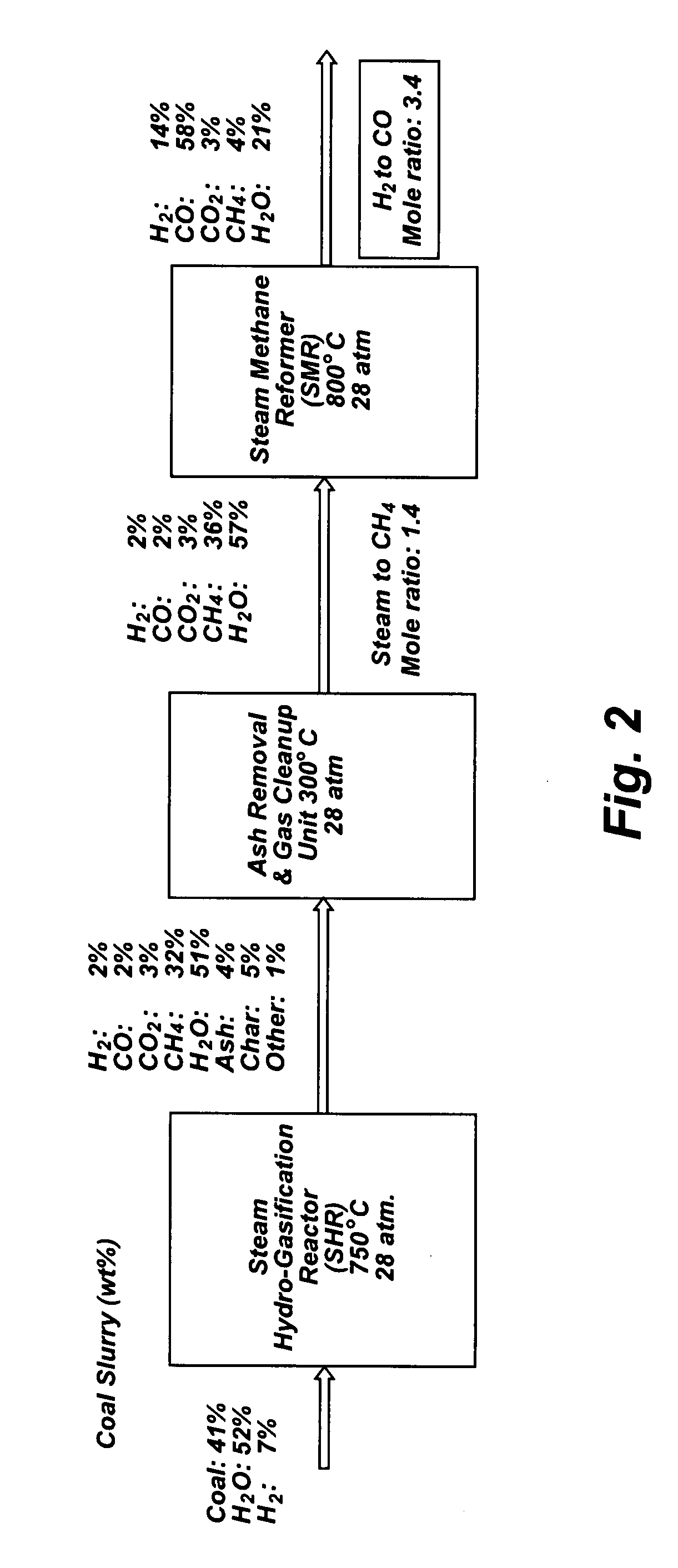Controlling the synthesis gas composition of a steam methane reformer
a technology of steam methane reformer and synthesis gas composition, which is applied in the direction of liquid-gas reaction process, combustible gas production, combustible gas purification/modification, etc., can solve the problems of reducing the catalyst efficiency, serious environmental pollution, and a major dependence on petroleum, so as to improve the effect of economics
- Summary
- Abstract
- Description
- Claims
- Application Information
AI Technical Summary
Benefits of technology
Problems solved by technology
Method used
Image
Examples
example 1
[0037]FIG. 1 is a flow diagram a SHR to SMR process one embodiment of the invention in which a desired H2 / CO ratio output of an SMR is, obtained by separating hydrogen from the SMR output, diverting it to the HGR, and adjusting the hydrogen feed and the water content of feedstock into the SHR that supplies the SMR. An internally generated hydrogen feed 10 is fed into an SHR 12 along with a carbonaceous feedstock 14 and water 16, which are heated to 750° C. at 400 psi in the SHR 12. The resulting producer gas is directed to a gas clean up filter 18, e.g. a candle filter assembly, at about 350° C. at about 400 psi. From there, after removal of sulfur and ash, the effluent is directed to an SMR 20 where synthesis gas is generated and fed to a Fischer-Tropsch type reactor 22, from which pure water 24, and diesel fuel and / or wax 26 is obtained. The SMR 20 output is passed through a hydrogen separator 27 where a portion of its hydrogen is separated and diverted from the SMR 20, at 28 to b...
example 2
[0042] This Example, shown in FIGS. 3-6, illustrates a second, preferred embodiment in which a portion of the output of the SMR is itself recycled. FIG. 3 is flow diagram of the SHR to SMR process in which a desired H2 / CO ratio output of an SMR is obtained by without separating hydrogen from the SMR output, but diverting a portion of the SMR output itself to the HGR, and adjusting the hydrogen feed and the water content of feedstock into the SHR that supplies the SMR. The process is the same as described in Example 1 but for those changes reflecting the direct use of a portion of the SMR as feed to the SHR. Accordingly, while some hydrogen is used to start the process, as shown in FIG. 4, discussed below, internally generated hydrogen feed is that component of the SMR output, as shown at 10a in FIG. 3. As in Example 1, the SMR portion 10a is fed into an SHR 12 along with a carbonaceous feedstock 14 and water 16, which are heated to 750° C. at 400 psi in the SHR 12. The resulting pro...
PUM
| Property | Measurement | Unit |
|---|---|---|
| Temperature | aaaaa | aaaaa |
| Temperature | aaaaa | aaaaa |
| Pressure | aaaaa | aaaaa |
Abstract
Description
Claims
Application Information
 Login to View More
Login to View More - R&D
- Intellectual Property
- Life Sciences
- Materials
- Tech Scout
- Unparalleled Data Quality
- Higher Quality Content
- 60% Fewer Hallucinations
Browse by: Latest US Patents, China's latest patents, Technical Efficacy Thesaurus, Application Domain, Technology Topic, Popular Technical Reports.
© 2025 PatSnap. All rights reserved.Legal|Privacy policy|Modern Slavery Act Transparency Statement|Sitemap|About US| Contact US: help@patsnap.com



